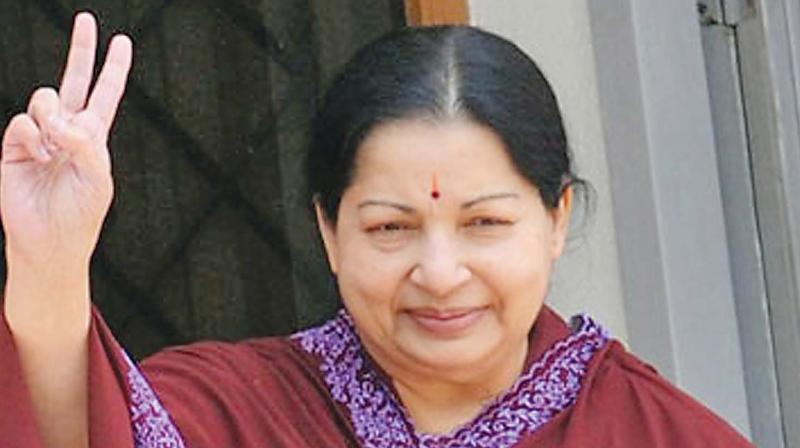Is Dravidian Movement cracking up in post-Jaya Tamil Nadu polity?
The new word pictures have raised questions about the future of the Dravidian Movement' in the State.

Chennai: It is barely three weeks since the untimely demise of the former Tamil Nadu Chief Minister and AIADMK supremo J. Jayalalithaa, but the media has been already saturated with predictions and possible scenarios in a post-Amma Tamil Nadu polity.
The new word pictures have raised questions about the future of the ‘Dravidian Movement’ in the State. This is amid the two major Dravidian parties, DMK that is yet to come to real terms with the party’s ageing leadership and the AIADMK that has been suddenly left rudderless, giving the impression that an over-worked political paradigm could well reach a point of least rejuvenation, giving its competitors a much sharper edge.
The turbulence witnessed in Fort St. George, the seat of the Government in Chennai, in the past week, in the wake of investigative actions by the Central agencies, and the way consequences of the Centre’s November 8 demonetisation of two high-value currencies have been grimly playing out, may even reinforce impressions of a deepening crisis.
The sum and substance of much of the political assessment, nuances apart, is that with both the major Dravidian parties on the ‘decline’, and the Congress already ‘nowhere’ towards regaining its lost ground in Tamil Nadu, history is unfolding the stage for the BJP, well placed at the Centre, and forces of right-wing nationalism to take that space.
The atmosphere tends to get more surcharged with a younger, tech-savvy and vocal section simplistically reducing all issues to corruption and governance. Yet, as the proverbial adage goes, even one day can be too long in politics. And predicting socio-political processes is always a perilous course, wherein only a thin line separates bare factual, ear-to-the-ground descriptive approach, from a self-fulfilling prophecy!
Historically, both the DMK and AIADMK, which have been dominating Tamil Nadu politics since 1967 and also deciding government formations in New Delhi in recent decades, have in degrees shed their intense regionalism and Tamil pride, part of the core of the ‘Dravidian Movement’, in their relationship with the Central government.
There have been important instances of such ‘cooperative federalism’, from the way an earlier Karunanidhi-led DMK government had backed much of the socialist policies of Mrs Indira Gandhi as Prime Minister, to a firm-willed Jayalalithaa-led AIADMK regime uncompromising in nipping Tamil militancy and terrorist tendencies in the bud, particularly in the post-Rajiv Gandhi assassination scenario.
A whiff of Tamil nationalism often comes to play, in issues like Cauvery, Sri Lankan ethnic crisis and Mullaperiyar dam, but successive governments have kept it at bay.
Even after the February 1998 Coimbatore serial blasts, when religious divide threatened to take hold of the State’s political discourse, it is to the credit of the inherent secular outlook in the people, that runs down right from saint-poet Thiruvalluvar’s days and nurtured by successive social reformers, both the Dravidian majors have not played divisive politics.
Yes, Ms Jayalalithaa did draw considerable flak for the controversial ordinance against religious conversions, but she later wisely allowed it to lapse, after the AIADMK’s debacle in the 2004 Lok Sabha polls. The political costs were too huge.
So, given this backdrop and more, is the ‘Dravidian Movement’ paradigm cracking up? The fact of the matter is, notwithstanding other issues about ‘total objectivity’ in the social sciences, the word ‘paradigm’ is often used rater loosely in political narratives.
The notion of a ‘paradigm shift’ is credited to the American physicist and philosopher Thomas Kuhn, who in his seminal work, ‘Structure of Scientific Revolutions (1962)’ had described it thus: “fundamental change in the basic concepts and experimental practices of a scientific discipline.” For him, a radical shift from the Newtonian notions of space and time to an Einsteinian one was one such ‘paradigm shift’ in physics after a ‘crisis point’ was reached in the then scientific paradigm. This idea as applied to the social sciences gets even more problematic, making snappy predictions all the more slippery.
But any fairly objective analysis would show that there is no such ‘crisis’ in the guiding paradigm of the ‘Dravidian Movement’ now. In fact, Ms. Jayalalithaa had ensured the continuation of the 69 per cent reservation in government jobs and educational institutions, in the wake of the Supreme Court verdict in the famous ‘Mandal case’.
So much so, despite her upper caste origins, the Dravidar Kazhagam (DK) leader, K Veeramani conferred Ms. Jayalalithaa the title, ‘Samuga Needhi Kaatha Veeranganai’.
The caste-based reservations including for Dalits, and the caste-based arithmetic that decides elections, continue to remain the bedrock of the ‘Non-Brahmin/Self-Respect Movement’, even if some of its other ideological aspects may have lost its virulence. Despite its shortcomings, the cosmopolitan ethos basically informing the ‘Dravidian Movement’ has nurtured an inclusive approach over long years, giving, what C.E.M. Joad said in another context, “a certain freedom from sectarian intolerance.”
There is a sense of fatigue among sections of the people with both the Dravidian majors, but to read ‘leadership crisis’ in individual parties as ‘tectonic shift’ in the underlying socio-political orientations in Tamil Nadu now, could be like the ‘irrational exuberance’ of the stock market.
The boundaries of the ‘Dravidian majors’ may get redrawn alongside a new alliance politics. But the new challenges like dovetailing what Nobel Laureate Amartya Sen calls a ‘capabilities approach’ into a secular, social justice model, and inter-state water issues, should be a wake-up call to all key political players in the State.

